
Gwich'in to Congress: Designate the Arctic Refuge Coastal Plain as Wilderness
November 29, 2016
Tuesday AM
(SitNews) Fairbanks, Alaska - For hundreds of generations, the Gwich’in people of Alaska and northern Canada have depended on the caribou that migrate through the Arctic Refuge. With their traditional culture now threatened by oil extraction and climate change, two Gwich’in women are continuing a decades-long fight to protect their land and future.
The Gwich’in people have lived in the Arctic National Wildlife Refuge region spanning from Alaska to Canada for hundreds of generations. The word “Gwich’in” means “people of the land,” and their lives and culture have become inseparable from the fate of the Porcupine Caribou Herd. The Gwich’in people and rely on caribou as their chief food source, as well as for clothing, tools and ornaments, and as a central fixture of their culture.
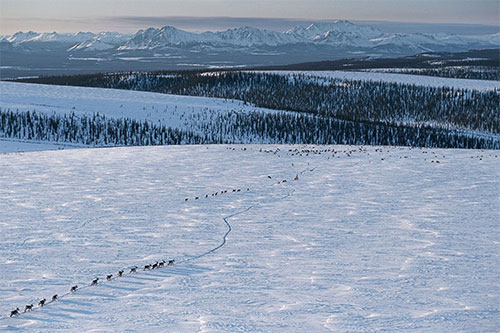
The Porcupine caribou herd returns to the Arctic Refuge during their annual migration. The refuge coastal plain is important to calving success and calf survival; there are fewer predators there than in the nearby foothills and mountains, as well as abundant plants for hungry new mother
Photo by Florian Schulz
The 1.2-million-acre coastal plain of the Arctic Refuge is the calving grounds of the 169,000-member Porcupine caribou herd, which has sustained the?Gwich’in people of Alaska and northern Canada for hundreds of generations. The Gwich'in people of Alaska and Northern Canada have fought for three decades to protect the Coastal Plain of the Arctic National Wildlife Refuge from oil drilling and other threats.
Supporting the efforts of the Gwich'in people of Alaska and Northern Canada on Monday outdoor apparel company Patagonia and non-profit conservation group Alaska Wilderness League released The Refuge, a 15-minute film telling the story of two Gwich'in women who are fighting for their ancestral home and the survival of the wild animals that bring them life. In conjunction with the film, Patagonia has partnered with Care2, the world's largest social media site for good, to launch a Care2 petition asking Congress to pledge to protect the Refuge's Coastal Plain as wilderness.
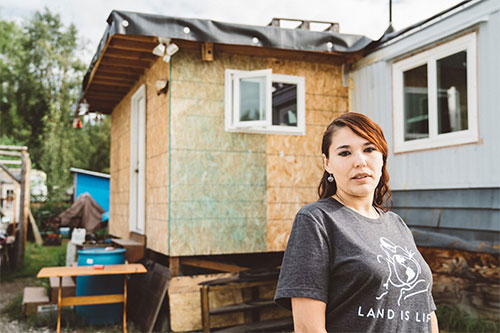
Bernadette Demientieff, Gwich’in Steering Committee executive director.
Photo by Kahlil Hudson
"Patagonia has supported the Gwich'in Steering Committee and Alaska Wilderness League through our Environmental Grants Program since the early 2000s," notes Rose Marcario, Patagonia's Chief Executive Officer. "We stand in solidarity with the Gwich'in community today to ask Congress to designate the Coastal Plain as wilderness and protect the Gwich'in way of life forever."
To the Gwich'in, the Refuge's pristine Coastal Plain where caribou calve their young is "the Sacred Place Where Life Begins." The coastal plain, although a true national treasure, lacks protection as wilderness and has become a target for drilling by the oil industry and its allies. It's now under more threat than ever – with pro-oil forces stating they will work quickly to push for drilling in the Refuge.
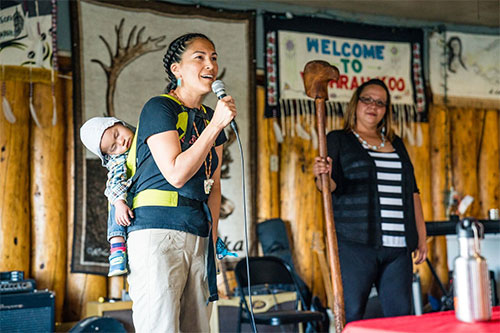
Princess Daazhraii Johnson, former executive director at the 2016 Gwich’in Gathering
Photo by Kahlil Hudson
"For decades the Coastal Plain, known as the Refuge's biological heart, has been in political limbo, at best, and nearly at the tip of a drill bit, at worst," said Cindy Shogan, executive director of Alaska Wilderness League. "But the Obama administration has given us all hope that the Arctic Refuge will be taken off the table forever. In January 2015, President Obama took an important step to recommend wilderness for the Refuge and its Coastal Plain. The president and his administration have done more than any other in the last two decades to protect the Arctic Refuge. Now, it's time for Congress to act."
"For us, this is a matter of physical, spiritual and cultural survival," said Gwich'in spokesperson Bernadette Demientieff. "It is our basic human right to continue to feed our families on our ancestral lands and practice our subsistence way of life. We ask that Congress take the next step to protect the Coastal Plain by designating it as wilderness."
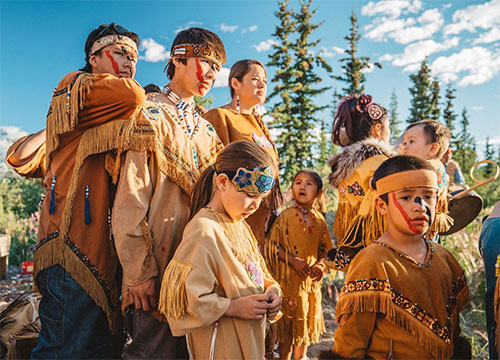
Young members of the Gwich’in Nation prepare for a traditional dance ceremony at the 14th Gwich’in Gathering in Arctic Village, Alaska.
Photo by Kahlil Hudson
The Arctic Refuge, located in the northeast corner of Alaska, covers 19.3 million acres and supports an impressive diversity of arctic and subarctic wildlife, including two caribou herds – the Porcupine Caribou Herd and the Central Arctic Caribou Herd. The Porcupine Caribou Herd in particular depends on the Refuge’s Coastal Plain, where calving occurs from late May to mid-July. Approximately 200 species of migratory birds have been seen on the Arctic Refuge – the Coastal Plain is especially important for shorebirds and waterfowl that nest on or otherwise utilize the area during the summer. All three species of North American bears – black, polar and grizzly – can be found on the Refuge. In fact, the Arctic Refuge contains the most important land denning habitat for U.S. polar bears in the entire Alaskan Arctic. Additional species found in the Refuge include moose, wolverines, and birds of prey such as golden eagles and peregrine falcons.
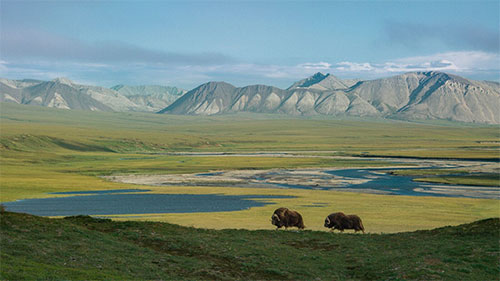
Musk oxen have been around since the Pleistocene era; along with caribou, they are the only hoofed animals that survived the end of that era (10,000 years ago). Today, they roam the open tundra of the Arctic Refuge in search of vegetation growing under or above the snon.
Photo by Florian Schulz
In Alaska, the Gwich’in reside in nine communities: Arctic Village, Beaver, Birch Creek, Canyon Village, Chalkyitsik, Circle, Eagle Village, Fort Yukon and Venetie. For thousands of years, the Gwich’in people have regarded the Coastal Plain of the Arctic Refuge as “Iizhik Gwats’an Gwandaii Goodlit” or “The Sacred Place Where Life Begins,” because it has been the most frequently used birthing and nursery grounds for the Porcupine Caribou Herd. The Porcupine Caribou Herd is the foundation for the social, economic and spiritual fabric of the lives of the Gwich’in people.
On the Web:
The Refuge, a 15-minute film telling the story of two Gwich'in women who are fighting for their ancestral home and the survival of the wild animals that bring them life.
https://www.youtube.com/watch?v=A4DH5cK37Y8&feature=youtu.be
CARE2 PETITION
http://www.thepetitionsite.com/takeaction/570/633/747/
Editing by Mary Kauffman, SitNews
Source of News:
Patagonia
www.patagonia.com
Alaska Wilderness League
www.alaskawild.org
Representations of fact and opinions in comments posted are solely those of the individual posters and do not represent the opinions of Sitnews.
Submit A Letter to SitNews
Contact the Editor
SitNews ©2016
Stories In The News
Ketchikan, Alaska
|
Articles &
photographs that appear in SitNews may be protected by copyright
and may not be reprinted without written permission from and
payment of any required fees to the proper sources.
E-mail your news &
photos to editor@sitnews.us
Photographers choosing to submit photographs for publication to SitNews are in doing so granting their permission for publication and for archiving. SitNews does not sell photographs. All requests for purchasing a photograph will be emailed to the photographer.
|
|





